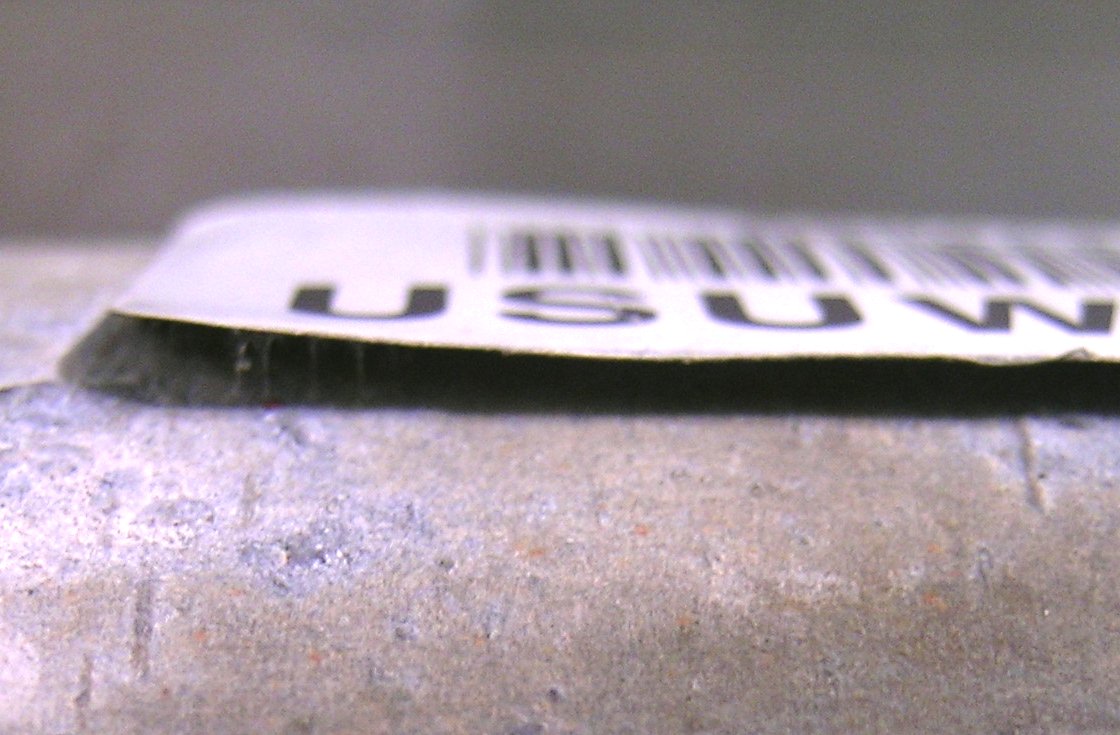|
Barcode Technology
Types of Labels
 SDTDC tested various types of labels to determine the types of label that are best suited for rugged environments. During these tests, labels were adhered to different types of surfaces and then exposed to extreme environmental conditions such as hot rain, cold rain, hot and dry, cold and dry, and chemical exposure.
SDTDC tested various types of labels to determine the types of label that are best suited for rugged environments. During these tests, labels were adhered to different types of surfaces and then exposed to extreme environmental conditions such as hot rain, cold rain, hot and dry, cold and dry, and chemical exposure.
The following are links to the documentation of the environmental and chemical test procedures.
Link to Environmental Chamber and Chemical Exposure Test Procedures.
The following are common problems, their cause, and a suggested solution.
 Always use labels on a clean, dry and flat surface.
Always use labels on a clean, dry and flat surface.
Labels that were applied to rough surfaces did not permanently adhere. Because of the rough surface, during high humidity or rain, water entered under the label and caused the adhesive to lose tack. This caused labels to easily peel, especially around the edges.
Use Synthetic-Labels for more rugged applications.
Major water damage occurred to paper labels or non-synthetic labels. Face stock became soaked causing ink to smear and labels to tear easily. Labels remained in poor condition even after labels were allowed to completely dry. Other than rain, water damage can occur in high humidity environments.
 Aluminum Labels have a memory effect.
Aluminum Labels have a memory effect.
Thin aluminum labels have a slight memory effect to the material. Problems occurred when placing these labels on cylindrical objects such as pipes. When these labels are applied around the curvature of a pipe, the aluminum tends to return to its normal position (memory), thereby pulling the adhesive up and away from the surface. This caused peeling edges on the labels that were placed on curved surfaces.
Ensure that label material and adhesive properties match each other.
Labels that are able to withstand extremely hot temperatures will still fail if adhesive is not rated for high temperatures.
| Label Material |
 |
 |
 |
 |
 |
Remarks |
| Polyester |
High |
High |
High |
High |
High |
Polyester provided maximum protection against all harsh environ-mental elements. |
| Aluminum |
High |
Medium |
Medium |
High |
High |
Deformation may occur during extreme temperature changes. Deformation can cause peeling. |
| Paper |
Low |
Medium |
Medium |
Low |
Low |
Paper labels have minimum protection against harsh environ-mental elements. |
| Polyolefin |
High |
High |
High |
High |
Low |
Other Synthetic materials performed very well against all harsh environ-ments except against chemical exposure. |
| Polypro-pylene |
High |
High |
High |
High |
Low |
| Polyst-yrene |
High |
High |
High |
High |
Medium |
 Water Resistance Water Resistance
 Heat Resistance Heat Resistance
 Label Strength Label Strength
 Cold Resistance Cold Resistance
 Chemical Resistance Chemical Resistance
|
For more information on the different types of label materials click on the following link:
Link to LABEL MATERIAL TYPES and also VENDOR INFORMATION
|


 SDTDC tested various types of labels to determine the types of label that are best suited for rugged environments. During these tests, labels were adhered to different types of surfaces and then exposed to extreme environmental conditions such as hot rain, cold rain, hot and dry, cold and dry, and chemical exposure.
SDTDC tested various types of labels to determine the types of label that are best suited for rugged environments. During these tests, labels were adhered to different types of surfaces and then exposed to extreme environmental conditions such as hot rain, cold rain, hot and dry, cold and dry, and chemical exposure.

